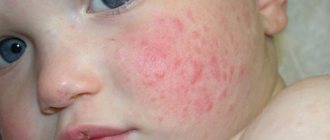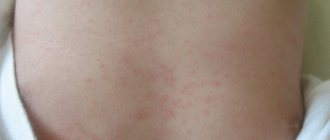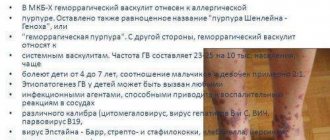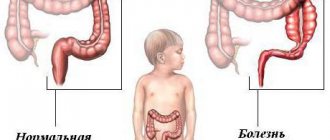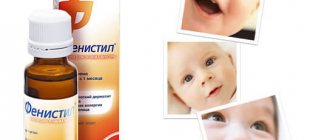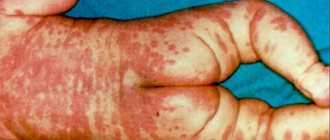01/20/2021 Reading time: 2 min 3337 0
- Features and symptoms of allergy to cats in children
- Why allergies are dangerous
- What to do if you have allergies
- What animals are you not allergic to?
Often, when a cat appears in the house, one of the family members begins to sneeze, itch, or experience other manifestations of discomfort. It is especially worrying if these symptoms appear in children. Let's figure out why a harmless pet can turn into a problem.
Signs of allergies
It is difficult to say exactly how an allergy to cats manifests itself in an infant.
Each baby is individual, for this reason the reaction of the immune system will be different. Symptoms of cat allergies are divided into several groups and include:
- Respiratory or catarrhal;
- Skin.
Skin manifestations include:
- Itching that does not go away for several days;
- Rash all over the body or at the site of contact with the allergen;
- Dryness of the epidermis;
- The appearance of crusts in places of scratching;
- Urticaria, which is characterized by swelling of the mucous membranes and skin.
If these allergic manifestations are left unattended and untreated, this will lead to the development of atopic dermatitis.
Catarrhal symptoms are presented:
- Nasal congestion and mucous discharge from the nasal passages;
- Redness of the conjunctiva;
- Tearing;
- Coughing.
The first sign of an allergic reaction is constant sneezing due to an itchy nose.
"Important information! The symptoms of allergies are similar to those of a cold, so it can be confused with ARVI.”
Parents may notice that the baby has begun to eat worse, be capricious, and rub his eyes. In addition, he became lethargic and drowsy. In some cases, the newborn may even develop a fever.
Allergy to cats in infants should not be underestimated. This is an extremely unpredictable disease that can be accompanied by suffocation, wheezing snoring and the production of viscous sputum, which is life-threatening for a newborn toddler.
If such symptoms are detected, parents should not hesitate; they should immediately call an ambulance.
Treatment options
The first stage of treatment for allergies to pets involves avoiding contact with them. It is impossible to completely eliminate contact with the allergen. Even after removing a pet from the home, there is always a chance that a child will come into contact with them on the street or through exposure to dust particles on other people's clothing.
But in order to quickly relieve the symptoms of the disease, it is not enough to simply exclude contact. It is necessary to begin treatment with medications. It is better to treat infants under one year of age under the strict supervision of specialists.
Allergy medications
Your doctor will prescribe one of the following medications to relieve nasal allergy symptoms:
- Antihistamines reduce the production of an immune system chemical that is heavily involved in an allergic reaction, and they help relieve itching, sneezing, and a runny nose. Antihistamines prescribed as a nasal spray include azelastine (Astelin, Astepro) and olopadatine (Patanaz). Over-the-counter (antiretroviral) antihistamine tablets include fexofenadine, loratadine (Claritin, Alavert), and cetirizine (Zyrtec Allergy). These medications are well suited for treating children;
- Corticosteroids prescribed as a nasal spray can reduce inflammation and control hay fever symptoms. These drugs include mometasone furoate (Nasonex), triamcinolone (Nasacort Allergy 24-Hour), and ciclesonide (Omnaris). Nasal corticosteroids require low doses of the drug and have a much lower risk of side effects than oral corticosteroids;
- Decongestants help tighten swollen tissue in the nasal passages and make breathing through the nose easier. Some allergy pills combine an antihistamine with a decongestant; Leukotriene modifiers block the action of certain immune system chemicals.
Other treatments
Immunotherapy. You can always “train” the immune system of a young body so that it does not show sensitivity to the allergen. The technique of using this method involves intentional contact with the allergen several times, until the child’s body fully adapts.
Nasal irrigation. Rinse with sea salt solution. If parents prepare saline solution themselves, it is necessary to use water that does not contain contaminants - distilled, sterile, pre-boiled and cooled. Or passed through a filter that has the smallest size.
Prevention measures and later life
A negative reaction of a child’s body to the presence of a pet may appear after short remissions. To avoid this, it is best to remove the animal from the house, but there are cases when the owners are very attached to their pet.
What causes allergies to cats?
When an animal lives in the house, particles of its dead skin, fur and saliva are everywhere. And no matter how carefully and often you clean the house, it will not be possible to completely remove traces of the cat’s vital activity. A child, exploring the world around him and playing, will inevitably encounter them.
Often, infants are allergic to cats not only as a result of contact with fur. Allergic manifestations also occur upon contact with the skin, saliva and urine of a pet.
It is these biological materials that become irritants, causing the body's immune response, because they contain protein.
Should you get rid of your cat?
There is an opinion that only long-haired cats can cause allergies, while sphinxes cannot provoke it. Actually this is not true. The saliva, feces, urine and sebaceous glands of hairless cats also contain protein, which means they can also provoke allergies, although to a lesser extent.
The concentration of protein compounds acting as irritants depends on a number of factors. The least dangerous for an allergic baby are:
- Female felines;
- Cats with white or light fur;
- Animals that were spayed before their first heat.
In addition, the likelihood of developing an allergy will depend on the breed of the animal. The breeds least likely to get allergies from cats are:
- Burma;
- Likoy;
- Savannah;
- Cornish Rex;
- Toyger;
- Javanese;
- Bengal;
- Peterbald;
- Canadian Sphynx.
It is up to the parents to decide whether to give up their furry pet or not. First of all, you need to consult with your pediatrician whether this is dangerous for the baby or not. It also depends on how an allergy to cats manifests itself in an infant, and what symptoms are typical for it. If the allergic reaction is minor, then proper care of the animal will reduce the manifestations of the disease to nothing.
"Note! With the right treatment, an infant’s allergy to cats will first be minimized and eventually disappear altogether.”
Risk factors
A child's hypersensitivity to animal fur is often determined at the genetic level. The gene that has undergone structural changes is passed on to the toddler from close relatives. If one of them is allergic to animals, then the baby’s chances of becoming allergic increase significantly.
"Note! If the baby is diagnosed with diseases of the immune system, then they can cause changes leading to disorders and the occurrence of various allergic reactions.”
Which animals do not produce allergens?
There are animals that will be safe even for a child suffering from chronic allergies. These include:
- chinchillas;
- turtles;
- fish;
- chameleons;
- lizards;
- Syrian breed of hamsters;
- cats with minimal hair;
- dogs with limited fur coverage.
Every child dreams of having a pet to take care of. But not everyone can afford it due to a certain reaction of the body. Before bringing a kitten or puppy into the home, parents should make sure that their child does not suffer from an allergy to animal protein. And if allergen tests are positive, then it would be better to give the child a hypoallergenic animal.
Complications if a child has allergies
An allergy to cats in an infant is a disease whose symptoms should not be ignored, as it causes extremely serious consequences, such as:
- Rhinitis with strong mucous discharge and constant nasal congestion;
- Conjunctivitis with itching and severe lacrimation;
- Bronchial asthma;
- Chronic eczema;
- Quincke's edema;
- Anaphylactic shock.
All these ailments can become chronic, which will significantly complicate the baby’s life, since their presence requires constant monitoring of the child’s condition, taking tests and taking medications.
What to do to leave your pet at home
The first rule is to close the doors to the nursery, where the child spends most of his time. Another good method would be to use an air purifier and constantly clean the room.
Please remember that animal fur is very sticky. If the decision to leave your pet at home has been made, it is best to completely clean the room and throw out old furniture and carpeting.
Washing your pet every week will reduce the presence of allergens in the air, but is of questionable value in reducing the child's symptoms.
It is necessary to clean the pet of dandruff (skin particles), and also clean its oral cavity, removing all rot from the teeth.
Before deciding to follow such complex preventive measures to leave the animal at home, you need to know that there are pets that do not cause allergies in children.
Diagnostic measures
An allergist knows exactly how allergies to cats manifest in infants and older children. To confirm the diagnosis, the child will need to undergo a specialized examination, represented by subcutaneous tests, which make it possible to accurately identify the allergen.
"Important information! You should be careful about the health of your newborn baby, since an allergic reaction to a cat can occur even when the pet is not in the house. The mucous secretion or fur can be brought home by parents or the baby himself, having been in a house where there are mustachioed pets.”
If the diagnosis is confirmed, the allergist will select appropriate therapy for the child. You cannot give your baby any medications on your own. Antihistamines have a lot of side effects and are not always suitable for children. If the drugs are selected incorrectly, serious complications can occur.
If parents do not have the opportunity to contact a specialist, then the cause of the allergy should be eliminated independently by giving the pet to relatives for foster care. If the allergy symptoms disappear, something else is causing the immune symptoms.
Traditional methods and homeopathy
Herbal infusions and homeopathic preparations are not suitable for curing cat allergies, but they make a child’s life much easier by relieving the symptoms of the disease. If you notice an allergic reaction, use the following available recipes.
To relieve sore throat and cough
- Motherwort. The dry grass is crushed, poured with boiling water in a ratio of 2:10, and infused. After filtering, gargle. Laryngeal swelling and cough will go away.
- Chamomile. Flowers are infused in boiling water, 1 tablespoon per 200 milliliters. Drink as tea or gargle 4-5 times a day.
Against lacrimation, swelling of the eyelids, conjunctivitis
- Chamomile flowers. Cotton pads are soaked in the infusion and the eyes are wiped in the morning, evening, and throughout the day.
- Weak tea. The product is filtered. Dip a cotton pad into a container of tea and squeeze out excess liquid. Rub the eyes or make a compress for 1–2 minutes.
For nasal congestion, rhinitis
- Aloe juice. Squeezed from washed leaves, diluted in half with boiled water. Instill 1 drop 3-4 times a day.
- Bay leaf and linseed oil. Pour 20 bay leaves with oil and leave for 7 days. Place the product in your nose after waking up, at night.
Against itching, skin rashes
- Infusion of bay leaf. Add to bath or use as lotion.
- Aloe juice. Cut the leaf in half and apply to the site of inflammation. Redness will go away after 2-3 procedures.
To immunize the body
- A mixture of herbs. Combine string, chamomile, licorice, valerian, and oregano in equal parts. Fill with water (300 milliliters), heat in a bathhouse. Strain. Give your child 1 teaspoon 3 times a day.
- Peppermint. A decoction of 2 tablespoons of herbs is filtered and given to children to drink.
Homeopathy
Tablets and powders are produced based on natural ingredients. It is convenient to use homeopathic remedies to relieve the symptoms of allergies to cats because you do not need to boil or infuse the herbs. It is enough to take a tablet or dissolve the powder in water. The following drugs are suitable for children:
- "Allergozan". Available in granule form. It is used for symptomatic treatment, seasonal and permanent maintenance of normal well-being. Used as an emergency way to get rid of a reaction to a cat.
- "Sambucus". Effective for allergic rhinitis, bronchitis. The granules need to be absorbed.
- "Phytocin DN". Ointment for the treatment of runny nose. Lubricate your baby's nasal passages before and after interacting with the kitten.
- "Petroleum". Suitable for children with reduced immunity. Effective for the treatment of itching and urticaria.
Important! Keep in mind that alternative natural medicine is not suitable for all children. If the baby cannot tolerate herbs, sneezes during spring flowering, or breaks out in a rash after baths with added extracts, forget about traditional methods.
Preventive actions
Infants are rarely prescribed treatment even if they have allergies. In order to minimize the risk of developing allergies, you must:
- Reduce the number of contacts between the child and the cat. The animal should not rub against the baby and his things;
- Make sure that the baby does not accidentally get into the cat litter box, since cat excrement is a strong allergen;
- Do not allow animals into the child's room. In addition, you need to make sure that the cat does not sleep in the baby’s crib;
- Remove all long pile carpets. They are where cat hair gets stuck the most;
- Clean the apartment every few days, and also bathe the cat once every month and a half;
- Wash and disinfect all objects that the cat comes into contact with.
By following these simple rules, you can reduce the risk of developing an immune reaction to an animal to a minimum.
Main features
In different children, the reaction may differ in intensity and location of manifestation. The most common signs may be:
- skin manifestations - rash, blisters, red pimples, hives, peeling and dry skin, irritation, small red dots resembling broken capillaries, etc.;
- catarrhal manifestations - conjunctivitis, rhinitis, lacrimation, redness of the eyes, itching in the nose, hoarseness, sneezing, red throat, dry cough, swelling of the eyelids, rhinitis, difficulty breathing, shortness of breath;
- systemic manifestations - increased temperature, decreased arterial blood pressure, swelling of the nasolabial triangle, blue under the eyes, drowsiness, increased moodiness or sudden changes in mood.
As a rule, the strongest reactions occur in newborns and infants, since their immune system is at the stage of final formation and is more vulnerable to the action of allergens, the distributor of which is the cat. The consequences for newborns can also be more serious.
In children, skin manifestations most often come first, since their skin is very thin and susceptible to various types of allergies.
